|
|
 Primroses Primroses
By Sydney Eddison
To my British mother, primroses were the essence of spring and a poignant reminder of the home she had left behind. While she loved her adopted country, she never ceased to miss the familiar landscape of northwestern England. Most of all, she missed primroses, emblematic flower of the British Isles. She described them to me in minute detail-the delicate six-inch stems, each bearing a single moonlight-yellow blossom the size of a coat button and flat like a wild rose. The common English primrose (Primula vulgaris), used to be as ordinary and abundant as its Latin name implies, and its familiarity bred in my mother, not contempt, but an admiration bordering on reverence. Nor was she alone. 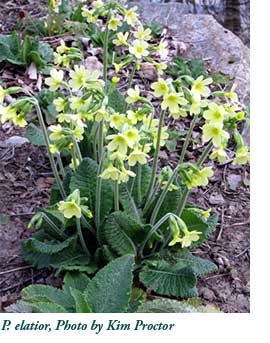 British botanist John Lindley (1799-1865), a lifelong admirer of the primrose and its relations, the cowslip (P. veris) and the oxlip (P. elatior), claimed that these three species of Primula were "so associated with our earliest recollections as children that we never, to the last hour of our existence, entirely cease to look upon them with pleasure. Nor indeed is it possible... to behold without delight a sunny bank all light and life with tufts of sweet yellow flowers, when nature elsewhere remains in the garb of death and winter." British botanist John Lindley (1799-1865), a lifelong admirer of the primrose and its relations, the cowslip (P. veris) and the oxlip (P. elatior), claimed that these three species of Primula were "so associated with our earliest recollections as children that we never, to the last hour of our existence, entirely cease to look upon them with pleasure. Nor indeed is it possible... to behold without delight a sunny bank all light and life with tufts of sweet yellow flowers, when nature elsewhere remains in the garb of death and winter."
Early bloom is certainly one of the charms of the genus Primula, which abounds in species that flower on the heels of winter. The name, primrose, derives from the two Latin words-prima, first and rosa, rose-thus, the first rose of spring. In my own garden, I have found P. abschasica holding a few purple blossoms above the melting snow. While I love the earliness of P. abschasica, my heart belongs to P. vulgaris, the pale yellow flower that I think of as my mother's primrose. Sadly, she did not live to see primroses blooming in my garden, but Martin, my English husband, did. In fact, he was instrumental in the development of the woodland garden, cutting down many of the smaller trees with his chain saw to give the primroses enough light. In England and in Europe the same primroses I grow in the shade can be found blooming in the open, but here they need protection from the heat of our spring sun, and during the summer, shade is essential to their survival. We began working on the woodland garden in 1978, after a snowbound winter. Mid-March, I became conscious of the sound of running water. It came from the wooded corner of our property behind the barn where a lively little stream poured forth from under the stone wall. As it fanned out, it lost momentum and wandered aimlessly among the rocks and trees before gathering in a man-made hollow. Our predecessors had tried to make this low spot into a pond, but the water dried up in the summer, and they abandoned the project. Inadvertently, they had created a vernal pool, the perfect site for several species of Primula. Meanwhile I had joined the North American Rock Garden Society (NARGS) and met the legendary Fosters. In 1966, H. Lincoln Foster and his wife, Laura Louise, always known as Timmy, had produced the rock gardener's bible, Rock Gardening: A Guide to Growing Alpines and other Wildflowers in the American Garden. Timmy was responsible for the delicate line drawings; Linc wrote the elegant, informative text. Through their writing and generosity in opening Millstream, their woodland garden, to visitors, the Fosters educated an entire generation of gardeners. Visitors were encouraged to wander the narrow paths among thickets of rare rhododendron, and Linc and Timmy conducted tours, pointing out special treasures and patiently answering hundreds of questions. Nor did their generosity stop there. They gave away scores of plants, cuttings, and seedlings. I came home starry-eyed from my first visit, with P. abschasica in a five-inch pot and inspiration for my own woodland garden. The Fosters and other members of NARGS introduced me to a world of primroses that would have amazed my mother. The genus to which her favorite flower belongs is one of the largest of all genera, boasting between 430 and 500 species scattered all over the northern hemisphere. The breadth of their distribution is matched only by the variety of their flower forms, their colors and their foliage sizes, shapes, and textures. Linc once wrote that "... the primrose tribe furnishes gardeners with so many magnificent plants that many have quite understandably forsaken all other genera and devoted their gardens and energies to primroses alone." Even if a primrose-infatuated New Englander wanted to be so exclusive, it is doubtful that the enterprise would be rewarding because so many primroses do not like our climate. Mountain dwellers object to our humidity; water-lovers and woodlanders, to our summer heat and frequent periods of drought. And even the toughest primroses find our winters stressful. In the absence of reliable snow cover, the ground freezes suddenly, lifting their roots out of the soil. When the soil thaws, the roots are left high and dry. Nevertheless, in a wooded site provided with a thick layer of leaf mulch in the winter, and planted in soil rich in organic matter, a dozen or more species will thrive. Long-lived stalwarts for Connecticut gardens include three species from Japan and the three natives of Europe and the British Isles. My mother's flower, April-blooming P. vulgaris, also known as P. acaulis, is not as common in nurseries as it deserves to be. It has sweetly scented pale yellow flowers, modest in size and tubular at the base. Each is clasped in a tightly-fitting pale green calyx. The corolla consists of five heart-shaped lobes, with a touch of orange where each attaches to the tube in the center of the blossom. A single clump produces many flower-topped stems that rise just above the crinkled, oval leaves, covering the whole plant with bloom. The cowslip, P. veris, and the oxlip, P. elatior, produce umbels of yellow flowers. If you are unfamiliar with the little cowslip you might be forgiven for thinking it belongs to some other genus. The small bright yellow flowers are almost bell-like and tucked into large, puffy calyces gathered into loose clusters at the top of sturdy stems. But if you look carefully at the flowers, you will see at once that they resemble tiny primroses with five small lobes, each with a telltale dot of orange at its center. 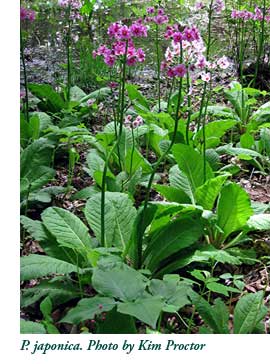 The oxlip, P. elatior is a more refined plant than the cowslip with taller stems and one-sided umbels of larger, pale yellow blossoms that could never be mistaken for anything but a primrose. In my garden they have self-sown and colonized a whole bank. No other primrose, except P. japonica , the Japanese candelabra primrose, has been so generous with its seed. The oxlip, P. elatior is a more refined plant than the cowslip with taller stems and one-sided umbels of larger, pale yellow blossoms that could never be mistaken for anything but a primrose. In my garden they have self-sown and colonized a whole bank. No other primrose, except P. japonica , the Japanese candelabra primrose, has been so generous with its seed.
I met these tall, eye-catching primroses, with their tiered flower stalks, growing thickly along the Foster's mill stream. The two-foot-tall stems rise out of leafy rosettes that look like large heads of romaine lettuce and boast as many as six tiers of flowers on each stem. The flowers come in vivid, showy shades of pink, rose, or magenta. In moist soil, they are among the easiest primroses to grow and form large stands that flower in mid-May. P. kisoana and P. sieboldii, also from Japan, flower and finish earlier. P. kisoana has a charming and desirable habit of spreading by thread-like stolons just below the soil surface. At the end of each thread, a new plant pops up a few inches from the parent. In time, the adults and offspring expand into sizeable patches. The pretty foliage, reminiscent of Heuchera, holds up well in the heat,as do the pink flowers, which develop into loose clusters atop six-inch stalks.  Finally, P. sieboldii is a real winner in Connecticut. It is one of the most permanent of all primroses, thanks to its habit of escaping into dormancy during the summer. In the spring, it arises like a princess from its long slumber, sending up wavy, scalloped leaves on long petioles followed by 10-inch stalks crowned with elegant flower heads. Individual blossoms can be as much as two inches across, and a large patch in full bloom is a stunning sight. Flower colors run the gamut of the pink scale to mauve and red-violet, and pure white or white on the flower face and red-violet on the back. Finally, P. sieboldii is a real winner in Connecticut. It is one of the most permanent of all primroses, thanks to its habit of escaping into dormancy during the summer. In the spring, it arises like a princess from its long slumber, sending up wavy, scalloped leaves on long petioles followed by 10-inch stalks crowned with elegant flower heads. Individual blossoms can be as much as two inches across, and a large patch in full bloom is a stunning sight. Flower colors run the gamut of the pink scale to mauve and red-violet, and pure white or white on the flower face and red-violet on the back.
This spring, Oliver Nurseries will be carrying a selection of primroses. I hope that the pleasure these enchanting flowers have given my mother and me will rub off on readers, and that in the future, no spring garden will be without a Primula or two tucked into the shade of tall shrubs or at the foot of a tree in a simple woodland garden. Sydney Eddison, author of Gardening for a Lifetime, has written six other books on gardening. She has been honored by National Garden Clubs, Inc., with their Award of Excellence for 2010. For her work as a writer, gardener and lecturer, she has also received the Connecticut Horticultural Society's Gustav A. L. Melquist Award in 2002; the New England Wild Flower Society's Kathryn S. Taylor Award in 2005; and in 2006, The Federated Garden Clubs of Connecticut's Bronze Medal. Her garden has been featured in magazines and on television. A former scene designer and drama teacher, Eddison lectures widely and is a frequent contributor to Fine Gardening magazine and other publications. Primula We Plan to Carry this Spring Primula vulgaris, P. veris, P. bullesiana, P. capitata 'Noverna', P. polyantha 'Francesca', P. denticulate alba, P. japonica, and P. sieboldii. |
|
|
|
|
|
|

Snow Damage
By Jed Duguid
One of my favorite sights is a pure white blanket of freshly fallen snow. But eight times in one season, come on already! Shovel the driveway, shovel the path, shovel the roof! Repeat. Who knew there would be so much snow this January that my Bernese Mountain dog laughed at me when I opened the door for her to go out? I would have cleared some of the snow off certain plants, had I known, but I kept thinking, "This has got to be the last storm." Then two more feet dumped and it was already too late. The majority of the gardens that surround my driveway are relatively young. Where else could we have put the snow? There was already way too much at the end of the driveway. I couldn't see traffic railing toward me until I was well committed to the road. Cars speed by fast enough when there's not an eleven-foot pile at the end of every driveway!
When the snow finally started to melt it was bittersweet. I was glad to pull out of my driveway without the fear I would be rushed to the hospital. However, as the gardens became exposed, the damage became apparent. It seemed like every plant I looked at didn't weather the weather so well. So many plants were crushed, broken or mangled beyond repair. The branches were literally torn off a Japanese white pine; the leader of a 'Curly Lamppost' maple snapped in two; and the lower four feet of my umbrella pine will never be the same. The Deutzia setchuenensis var. corymbiflora looked as if a tractor-trailer ran over it, backed up, and then ran over it again. How does it all happen? Worst of all was the breakage on the Japanese maples... the poor things didn't stand a chance.
After the initial shock, things didn't seem quite so bad. Yes, all the damage was still there, but as every other good gardener, I am well-equipped to handle the situation. For most of the plants, my trusty Felco pruners were up to the task. Azaleas, rhododendron, boxwood, Japanese holly and Pieris all got their broken branches clipped out, then a little haircut to help even them back out. They'll all be fine, possibly a little (or a lot) ugly this year, but just fine. My Japanese white pine is now missing a layer of branches-the form is not quite what it used to be, but it'll live and looks fine. Branches don't sprout from old wood on pines, so it is really important to pay attention as you prune them, and think about every cut you make. My unusually ravaged Deutzia will be clipped to the ground and should hopefully come back with a vengeance.
The Japanese maples required a little more than a creative clipping. The hardest hit was an older specimen, 13-feet across, five-feet high and a 6-inch caliper. There was a large split down the center of the trunk, and some of the older branches snapped off. If I had any chance of saving it I was going to have to get the two halves of the trunk back together. Nothing a drill, a pair of stainless steel lag bolts, and two guys on a cool day couldn't handle (hopefully). Plants are extremely resilient, and even though this behemoth looked terrible it certainly was worth the try. After all, late winter is when many nurseries are grafting Japanese maples. This was not the ideal candidate for grafting, but the concept is the same. If you can match cambium from one piece of wood to another, the two pieces can grow together and heal. The first step was to gently push the two halves of the tree toward one another to make sure that they'd be tight when bolted together. Upon seeing we could get them pretty close, we drilled two pilot holes several inches apart through one half of the split trunk. Afterward, it was easy as driving the lag bolts through one half into the other (while the two halves were pushed tight against one another). When we let go, the tree was held strong in place! Then, a few 1¼-inch stainless screws for some of the smaller branches, a bit of plant tie ribbon (grafting tape also would have worked it we'd had it), and a lot of creative pruning for many branches that didn't stand a chance finished the job. To tell you the truth, the tree now looks better than it has in a few years. I just hope it leafs out this spring.
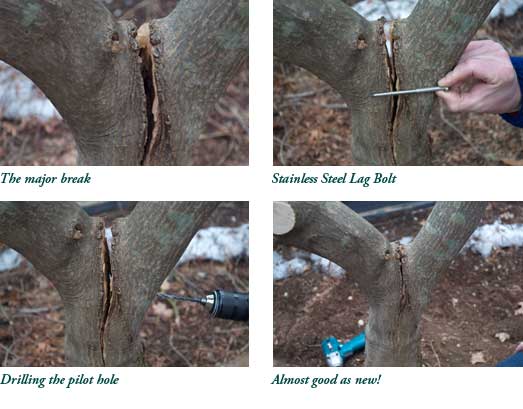
Many of you probably have some plants in similar states coming out of this winter. Survey the damage. I know many plants can likely be saved if you act soon. All it will take is an hour or two of time and a little creativity. Even with the infinite number of broken branches and bruised hearts, I'm sure this spring will never seem so sweet.
|

Miniature Dwarf Bearded Iris
for Rock Gardens and Troughs By Lori Chips Diminutive Iris are hot right now, and it's easy to see why. It's hard to imagine anything more charming than the upright swords of a miniature iris tucked behind a beautiful stone ─ unless it's one in bloom, topped by its classic fleur-de-lis. Iris always look so at home near stones and steps. They perform well there, too. 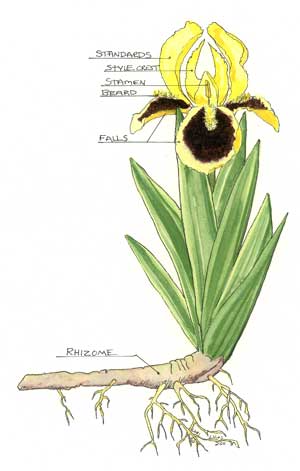 The name Iris encompasses a huge clan with many sections and divisions. Miniature dwarf bearded Iris is a classification of the genus for plants that measure eight inches tall or less. The blooms, however, can be rather enormous given the overall height of the plant. These little iris can pack a punch of color. Their bloodlines are complicated, including a combination of Iris lutescens plus I. pumila and I aphylla, the latter two being deciduous and thus lending extra hardiness to the plants. Although chromosome testing has begun to straighten out some of the breeding questions, it is unlikely that the parentage of these beauties will ever be completely disentangled. The name Iris encompasses a huge clan with many sections and divisions. Miniature dwarf bearded Iris is a classification of the genus for plants that measure eight inches tall or less. The blooms, however, can be rather enormous given the overall height of the plant. These little iris can pack a punch of color. Their bloodlines are complicated, including a combination of Iris lutescens plus I. pumila and I aphylla, the latter two being deciduous and thus lending extra hardiness to the plants. Although chromosome testing has begun to straighten out some of the breeding questions, it is unlikely that the parentage of these beauties will ever be completely disentangled.
Before I started studying these plants in earnest, I decided to look briefly into the origin of their name. I am easily entranced by the often quirky links found between science and mythology. The beautiful Iris did not disappoint me. A relative latecomer to the Greek Pantheon, Iris was the goddess of the rainbow and a messenger between Olympus and mortal men. Her highway was the rainbow. There are references to her in Homer's Iliad, although previously, in The Odyssey, Hermes instead performs the role of messenger. It's interesting, too, that the most feared and unattractive goddesses of all, the Harpies, were her sisters. So what is the connection between the goddess and the familiar flower? Apparently the Greeks used to plant iris on the graves of their women, in part to entreat the favor of the goddess. Though we cannot know the thought process of these ancient people, we assume it is a short jump from the name of the goddess to the name of the flower. Much later in history we find that Iris pumila 'Atroviolacea' traveled west with the pioneers and is often found planted on old graves in cemeteries across the United States. Although these cultivars are hybrids and boast some luscious colors, they do not look amiss in rock garden settings. The smallest can even find homes in a trough. If this is where you wish to place them, however, pay attention to the scale when combined with other plants. An iris, no matter how small, can still be too big near a dwarf shrub. Sometimes it is simply best to let the iris be the upright accent all on its own, then garnish your trough with buns and cushions, tiny groundcovers and trailers. It is important to recognize that the blossoms themselves can be extremely variable from year to year and garden to garden. One year the expected dark spot on the falls will be dark and distinct, the next it may be fuzzy and faded. Particularly wet weather can cause irregular streaking and patching. For best results, offer them phosphorus. Always provide impeccable drainage. Failure in this regard can mean failure altogether. One element that is utterly out of our control, but interesting: a cold winter will cause an increased flower count ─ a good thing to know, and which will mollify us after warm winters leave us feeling shortchanged. Finally, these miniatures, just as their big border cousins, need regular dividing. Do this right after flowering is completed. The great news is that it's swift and easy. A hand fork and a couple of minutes, and you're done! This spring we will be carrying: Iris 'Alpine Lake' - early 6" tall, white and soft blue Iris 'Bugsy' - 6" tall, yellow with a dark blotch on the falls Iris 'Dainty Morsel' - early/mid 6" tall pink self Iris 'Ditto' - very early 5" tall, white with dark blotch on falls Iris 'Fission Chips' - late 7" tall, orange self Iris 'Velvet Toy' - remontant (rebloomer) blue/violet Iris 'Wiggle' - 7" tall, yellow/wine Iris have a lot of terms that go with them, so here is a very brief glossary. - Amoene - a flower bearing white standards and colored falls.
- Beard - the thick brush of hairs found on the falls.
- Bicolor - where standards and falls are two different colors, the falls usually darker.
- Bitone - where standards and falls are the same color but of different value, such as light and dark blue.
- Falls - three downward curving lower sepals.
- Remontant - blooms at the usual time and then re-blooms again later.
- Rhizome - the thick underground stem from which roots emerge.
- Self - a flower with standard and falls of the same color.
- Signal - a spot pattern of different color on the falls just below beard.
- Standards - (banners) three upright incurving petals.
- Style - a crest or claw.
Lori Chips © 2011 |


|
 Early Bird Clematis Early Bird Clematis
By Melanie Fox
The array of flower forms in the world of clematis makes it tempting to try to have them flowering all the time. However, since my gardening zone is not followed by an 8, 9, or 10, I have resorted to collecting clematis that flower early to extend my semi-tropical feel as long as possible. My neighbors are now so accustomed to my seasonal eccentricities that to see me poking at my fence panels in mid-April looking for buds on my "Early Bird Clematis" will not even garner me a second glance; they are inured. One April, I spent two weeks flat on my back in the garden photographing my hellebores. In the months before, I could be seen peering at the ground looking for my snowdrops, and minute blooms of cyclamen coum. In the fall, they routinely see me stabbing the ground with a pry bar dropping minor bulbs in and stomping the earth closed. Someone has to keep seasonal rituals alive! 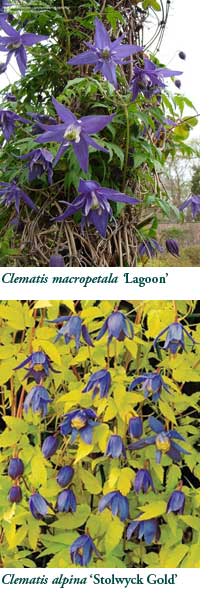 So you are probably asking, "What is an 'Early Bird Clematis?'" I think of the Early Birds as Clematis macropetala and Clematis alpina, two species which have a profusion of small, somewhat fluffy blooms in pink, blue or white. Both species are intermediate in stature, usually topping out around 8-10' making them ideal to scramble through a robust shrub, small tuteur, or on an ornamental lattice. These clematis generally flower in April here in zone 6b and I eagerly await that first shower of blossoms. My Clematis macropetala 'Lagoon' is planted on a fence panel and creates a tapestry of blue blooms. It has its feet covered with drifts of Narcissus 'Jet Fire' and Ipheion 'Rolf Fiedler.' It's a picture that I relish year after year. They do not tend to be re-bloomers, but I have been reading about some of these Clematis varieties that are remontant (Clematis macropetala 'Albina Plena' and C. alpina 'Bettina,' for example). The flowers are not the large flat blooms of the summer-blooming hybrids which can be seen languidly twining around mailboxes or covering arbors in June through August, but the floral display on mature plants can be remarkable. Lori Chips recounts that our Clematis alpina which grows up a standard witch hazel in the garden has caused more than one spring customer to request the name of the rare, blue-flowering tree! One of our new favorites here at the nursery is Clematis alpina 'Stolwyck Gold' which combines glowing chartreuse foliage with deep blue blooms. We grow it in combination with C. integrifolia 'Roguchi,' whose blue bells are beautifully accented by the bright foliage. So you are probably asking, "What is an 'Early Bird Clematis?'" I think of the Early Birds as Clematis macropetala and Clematis alpina, two species which have a profusion of small, somewhat fluffy blooms in pink, blue or white. Both species are intermediate in stature, usually topping out around 8-10' making them ideal to scramble through a robust shrub, small tuteur, or on an ornamental lattice. These clematis generally flower in April here in zone 6b and I eagerly await that first shower of blossoms. My Clematis macropetala 'Lagoon' is planted on a fence panel and creates a tapestry of blue blooms. It has its feet covered with drifts of Narcissus 'Jet Fire' and Ipheion 'Rolf Fiedler.' It's a picture that I relish year after year. They do not tend to be re-bloomers, but I have been reading about some of these Clematis varieties that are remontant (Clematis macropetala 'Albina Plena' and C. alpina 'Bettina,' for example). The flowers are not the large flat blooms of the summer-blooming hybrids which can be seen languidly twining around mailboxes or covering arbors in June through August, but the floral display on mature plants can be remarkable. Lori Chips recounts that our Clematis alpina which grows up a standard witch hazel in the garden has caused more than one spring customer to request the name of the rare, blue-flowering tree! One of our new favorites here at the nursery is Clematis alpina 'Stolwyck Gold' which combines glowing chartreuse foliage with deep blue blooms. We grow it in combination with C. integrifolia 'Roguchi,' whose blue bells are beautifully accented by the bright foliage.
Clematis macropetala 'Constance' is on my spring short list to add to my pink and purple clematis power panels where I already grow C. texensis 'Duchess of Albany,' 'C. purpurea plena 'Elegans,' 'C. 'Comtesse de Bouchard,' C. 'Perle d'Azur,' C. viticella 'Madame Julia Correvon,' and C. viticella 'Betty Corning.' The addition of the beautiful pink blossoms of C. alpina 'Constance' will stretch my season of bloom from April through August. Not bad for gardening in zone 6! Other notable selections are C. macropetala 'Lagoon' which flowers very early with luxuriant deep-blue double blooms, followed by wonderful silver grey seed heads. Clematis alpina 'Bluebird' is another wonderful variety that flowers into early June. Still on my "to be acquired for the nursery list" are C. macropetala 'Albina Plena' with very double, soft-white flowers which nod slightly. It blooms heavily on old wood in April with some re-bloom on new growth in summer. I missed getting this bridal beauty for this year, but look for it spring 2012! Clematis alpina 'Bettina,' with delicate, dark-purple flowers with white centers, is reported to flower continuously from April-August.' I can't wait to trial it! 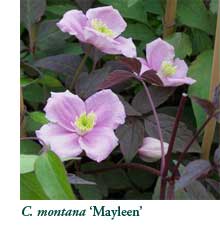 No list of early clematis would be complete without mentioning the gorgeous rambling zaftig beauties of Clematis Montana. They are tall ladies lush with foliage who cover themselves with anemone-like vanilla-scented blooms in May. They are the life of the robust May Garden Party. No mean feat, considering what a flower-filled month May is! I have seen these girls weigh down frail arbors, climb unaided to drape themselves over telephone wires, or surge up a weeping Katsura tree to produce a stunning waterfall of soft pink blossoms. A short list of my picks is the older variety C. Montana var. rubens whose beautiful bronze foliage sets off those pale pink blooms. C. montana 'Mayleen' is another favorite here at Oliver's with darker pink flowers combined with stunning foliage, and typical robust habit. My wish upon a star variety is C. Montana 'Freda' with cherry-pink blooms and wonderfully deep burgundy foliage. Perhaps next year! The montanas are well worth inviting into your garden or tree canopy. No list of early clematis would be complete without mentioning the gorgeous rambling zaftig beauties of Clematis Montana. They are tall ladies lush with foliage who cover themselves with anemone-like vanilla-scented blooms in May. They are the life of the robust May Garden Party. No mean feat, considering what a flower-filled month May is! I have seen these girls weigh down frail arbors, climb unaided to drape themselves over telephone wires, or surge up a weeping Katsura tree to produce a stunning waterfall of soft pink blossoms. A short list of my picks is the older variety C. Montana var. rubens whose beautiful bronze foliage sets off those pale pink blooms. C. montana 'Mayleen' is another favorite here at Oliver's with darker pink flowers combined with stunning foliage, and typical robust habit. My wish upon a star variety is C. Montana 'Freda' with cherry-pink blooms and wonderfully deep burgundy foliage. Perhaps next year! The montanas are well worth inviting into your garden or tree canopy.
I hope you are inspired to add some of these graceful spring beauties to your garden palette. They are easy to care for and will reward you generously year after year in those early spring days when each new bloom is a treasure. Pruning: Group A or 1 for Clematis alpina and C. macropetala. For Clematis montana, prune after bloom.
The following is a list of what will be available Spring 2011 Clematis alpina 'Constance.' 3'H x 3'W. Gorgeous deep-pink petals and deep-pink and white staminoides. This is a must have "Early Bird Clematis." Zone 4. Clematis alpina 'Stolwijk Gold.' 6-8'H x 2'W. Deep-blue flowers contrast beautifully against bright chartreuse leaves make this plant a knockout! Blooms slightly later than most C. alpinas in May-June. Clematis macropetala 'Lagoon.' 15'H x 3-6'W. Deep-blue flowers, very double, very early, profuse. Beautiful silver-grey seedheads. Flowers early April. Zone 3. Clematis montana var. rubens. 18-24'H x 6'W. Very robust clematis with exquisite pale pink, four- petaled flowers with a delicious vanilla fragrance. Perfect for a big arbor or growing through a small tree. Clematis montana 'Mayleen.' 18-24.' Gorgeous pale pink flowers with bronze leaves.
|
|
 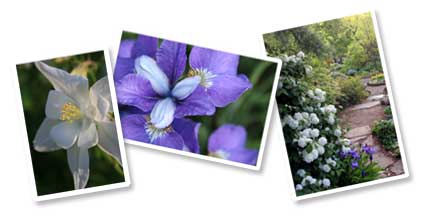
Share Your Gardens with Us
You've seen our gardens, and now we'd like to see yours. This year, we have a new digital display in the office. We plan to put up some of our work and our favorite plants. If you have digital photos of your favorite plants, flowers, gardens or vignettes that you'd like to share with us and other Oliver Nurseries customers, please send them to: mimi.dekker@olivernurseries.com.
|

 For more information visit our Web site at www.olivernurseries.com, or call us at 203-259-5609. For more information visit our Web site at www.olivernurseries.com, or call us at 203-259-5609.
Image in header: Detail from Spring, engraving by Bruegel. The Metropolitan Museum of Art. Dick Fund, 1926.
Copyright 2011 Oliver Nurseries
|
|
|
|
|
|
|
|